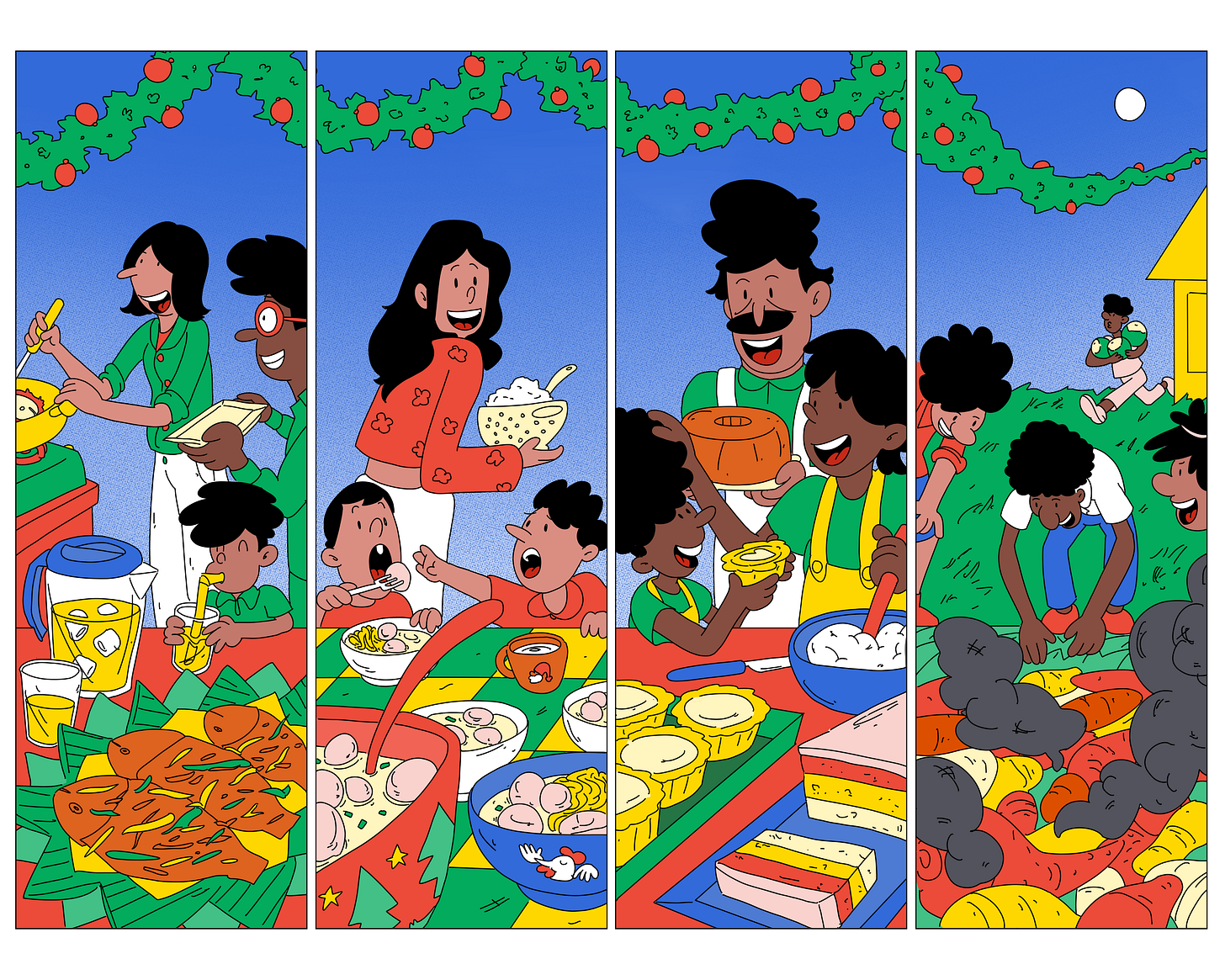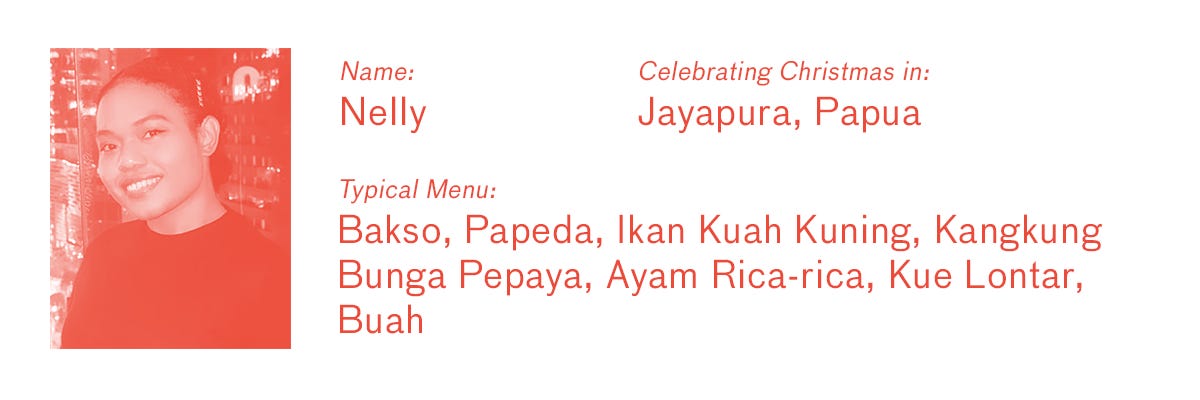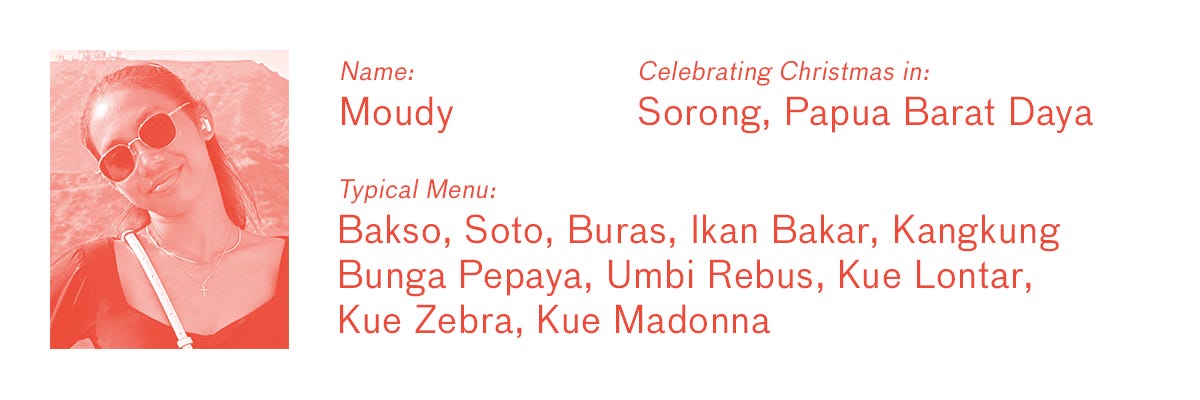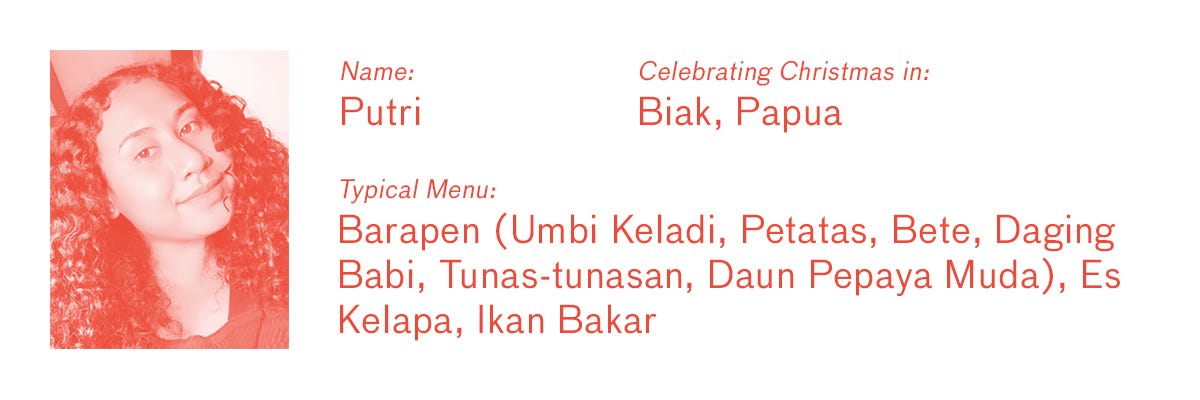A Very Indonesian Christmas Feast
Ever wondered how a Christmas feast looks like in a tropical country with over 17,000 islands and 1,000 ethnic groups? Yeah, me too.
“What’s a typical Christmas food in Indonesia?”. I’ve been thinking about that question for quite a bit. Not only that I don’t personally celebrate Christmas, but the word ‘typical’ is also very subjective, especially in a country with over 17,000 islands and 1,000 ethnic groups. What’s considered typical for me, might not be the same for the others.
So here’s my guess: there is no one, single, food that unifies all of us (Indonesians) when it comes to Christmas celebrations.
Unlike the Spanish, who have their Roscón de Reyes (crown-shaped cake), and the Japanese, who have KFC for Christmas, I really cannot think of a food that is being served in every, or at least most of the households here in Indonesia. Maybe that’s on me. Maybe I’m just way more exposed to a more Westernized menu like roast beef, turkey, and potato salad that is commonly served in restaurants in Jakarta. But I’m sure, there are more interesting, and more Indonesian food that is being served on the table.
To find out, I reached out to people who actually celebrate Christmas. I wanted to tell a story that truly represents Indonesia, a challenging task to do considering how big we are. So the least that I can do is to share and highlight stories from underrepresented areas - something that is as Indonesian as those who have received more attention. Somewhere beyond Jakarta, somewhere other than Pulau Jawa.
Let’s say hi to all of the contributors for this special story:
(1) Ranessa (she/her) is an employee of a state-owned company in Jakarta. Her family is originally from Medan, Sumatra Utara1, but moved to Batam, Kepulauan Riau2 when she was around 6 years old, where she spent most of her childhood. She is so used to moving to different places, during her university days in Bandung, Jawa Barat3, she would regularly go across the islands to visit her paternal family in Perdagangan, Sumatra Utara4 to celebrate Christmas.
(2) Moudy (she/her) is a Psychology university student based in Utah, USA. Her family is originally from Biak, Papua5, but she was born and raised in Sorong, Papua Barat Daya6. She is one of the awardees of an international scholarship targeted at Papuan youth, where she met with other like-minded individuals, eventually forming Zenderawasih - a platform / collective that educates people to know more about Papua in multiple aspects.
(3) Nelly (she/her) is a Business Management university student based in Wyoming, USA. Her family is originally from Waropen, Papua7, but she was born and raised in Jayapura, Papua8. She is also one of the scholarship awardees and a part of Zenderawasih.
(4) Putri (she/her) is a college student currently based in Jakarta, Indonesia, where she is now preparing for her departure to Wyoming, USA to study International Study. She was born and raised in Biak, Papua. She is also one of the scholarship awardees and a part of Zenderawasih.
(5) RG (she/her) is a Health, Society, and Policy university student based in Utah, USA. Her family is originally from Biak, Papua but moved here and there and spent most of her time in Jayapura, Papua. She is also one of the scholarship awardees and a part of Zenderawasih.
Let’s start waaay way before Christmas.
For most of us, Christmas celebrations usually start on Christmas Eve. That’s the time for Malam Kudus (Silent Night) where we gather at the church for Christmas Eve service. But for Ranessa and Nelly, Christmas would usually start weeks or even months earlier before the 24th of December.
Ranessa told me about how she got to visit different places on the island to be able to meet all of her extended family that is scattered across Sumatra Utara. “Almost every year, I would already be at Perdagangan around the 19th or 20th of December. And I usually even went to Medan before that to visit my maternal family there” Ranessa told me.
Meanwhile, Nelly’s family is always super excited for Christmas, they started to decorate their house three months before. “My Mama would start repainting the house in October. Before we even put on our Christmas tree, we would repaint our house first. Every year it would be a different color. But since we like blue lately, we’ve been repainting our houses with (different shades of) blue every year” Nelly shared with a laugh.
I later discovered that repainting houses is a common practice carried out as a family tradition across Papua, along with visiting the graves of passed loved ones to light some candles, share prayers, and as a sign of remembrance.
And as we’re getting closer to Christmas Eve, everyone is basically now in full Christmas, festive, chaotic mode.
At least that’s the impression that I got from Moudy, describing her trip throughout the city of Sorong. “Every year on the 24th, we would always go to the stores to buy missing things and ingredients for the next day. I don’t know why we are always missing things. But we needed to do it on that day because we would be welcoming guests on the 25th and most of the stores would not be open” Moudy explained.
While Moudy is busy getting lost in between the supermarket aisles, Putri is probably busy too - preparing for her Papa’s birthday. “My Mama’s relative would arrive at my house in the morning. We will then cook for dinner together so that everything can be served after the Christmas Eve service. During dinner, we would eat together, express our gratitude, and the kids would play with fireworks” told Putri.
This family get-together on Christmas Eve is also something that Ranessa experiences. In her family's Batak culture, this would mean spending a dedicated time doing Mandok Hata. “It’s an event to express apologies and humility. Something that we don’t have the word for in the Batak language” said Ranessa, explaining that the word ‘Sorry’ doesn’t really exist in her culture’s language. “During Mandok Hata, everyone needs to speak in front of all the family members (to apologize and express humility). Which usually leads to everyone crying and hugging each other in the end” she added.
Then, after the supermarket chaos, a birthday bash, and a heartwarming gathering on the 24th, comes Christmas Day which invites even more chaotic festivity.
“Every Christmas morning, everyone in the house would prepare the bakso9 quickly, making sure that we’re not late for church because the Morning Service usually starts at 9 AM”, said Nelly. “Once the bakso was ready, my Mama would set two tables for serving. One is for the bakso and all the condiments that come with it, like egg noodles, rice noodles, kecap manis, and sambal, and another table for the other main dishes like steamed white rice, papeda10, ikan kuah kuning11, kangkung bunga pepaya12, and umbi-umbian13” she continued.
“My favorite is always the bakso. Even before the guests arrived, my family would eat them first. My mama would even say ‘Hey! Are these bakso for us or the guests?’” Nelly added while laughing.
Similarly, this situation is also happening in Moudy’s kitchen. Her home is known for serving a lot of cakes during Christmas, in fact, she personally too can make a damn good kue lontar14. “We usually have quite a lot of cakes. My Bunda (mother) would usually make kue lontar, kue zebra, and kue madonna. We would pull an all-nighter to make these cakes, and I would borrow mixers and stoves from my Aunt. In the morning, the whole kitchen doesn’t even look like a kitchen anymore because it’s filled with stoves lining up“ Moudy explained.
The day continues with a Morning Service at the church, followed by a brunch or lunch at home with family, relatives, and other arriving guests.
For Putri, this time would be the main highlight for her Christmas as she would do barapen15 with her entire family at the back of her house. “We first put all the umbi-umbian as it takes the longest to cook, and on top of that, we would put the pork (already seasoned with garlic, salt, and lemon) and wrap it in banana or older papaya leaves. On top of the pork, comes the veggies as it doesn’t take long to cook - usually shoots and younger papaya leaves. Everything is then covered with a tarp or a billboard paper.” Putri shares.
"The pork is this big," said Putri while pointing to her entire arm to show that it was an arm-long size cut of meat. "One meat wrap is intended to be shared for one family. There will be tables, usually for eight people, and the wrap will be opened and served in the middle while everyone is sitting in a circle," she added. After the meal, she also explained that everyone would just casually pick some coconut from the trees to drink. Honestly, slay. Just Biak Island things.
For most Papuans, it is also common to hold an Open House during Christmas Day. Neighbors, extended family members, work colleagues, and even random, passing-by people would flock around the city to visit each other.
Some people like Moudy, would use this opportunity to go around her housing complex to do pegang tangan (peta)16, securing goodie bags filled with cookies and candies that were given by her relatives.
For RG, an Open House would mean welcoming family members and their fresh catch from the regional area. “Every year, some relatives from the regional area would come on the 25th or 26th. They would bring a whole fresh fish, and we would cook it together, turning it into ikan bakar (grilled fish) or ikan kuah kuning”. I mean, that’s what families are for right? You bring the fish, and I cook it for you.
Now that it’s past lunchtime, let’s check on what’s happening in Perdagangan because it seems like Ranessa is having a chill time with her cousins.
“There’s this one really special dish in Perdagangan called gorsam” Ranessa's eyes light up as she starts sharing her afternoon rituals on the 25th with her cousins to hunt for some bananas. “Gorsam is short for goreng (fried) sambal (chili sauce/paste). So they use pisang raja17 which they chopped length-wise, fried with a light batter, and topped with a spicy black-colored sambal like the one you would find in pempek18. It’s crispy, sweet, and spicy. Like, actually spicy” she added.
“In Perdagangan, there’s only one gorsam seller and they’re a Muslim. They only open around 1-4 PM because it sells out really fast. We usually bought them for our Christmas dinner along with some es cincau19 that comes in one-liter bottles. It’s so good (gorsam), I can finish five portions by myself” she recalled.
Once she secured the goods, she brought them back to her Opung’s (Grandparents) house to be served along with the other dinner lineup at a very long table, enough for 18 people. She explained that during dinner, the table would be full of huge cooking pots filled with steamed white rice, arsik20, saksang21, and ayam gota. Few of them are true Batak delicacies that use some very special ingredients like andaliman peppers and pork blood.
“I really love ayam gota. It’s a chicken, usually free-range, cut into big chunky pieces, and cooked (braised) with spices like andaliman pepper and pork blood. Somehow the (pork blood) tastes quite spicy. Honestly, I think I would be scared to try it if someone told me first that it was pork blood” she explained.
The night in Perdagangan usually continues with a karaoke session, tortor dancing, tamarillo juice, and tuak. But as exciting as it sounds, all of this doesn’t beat what comes in the next morning.
For Ranessa, breakfast on the 26th is the fun part. “In the morning, all the kids would already be waiting (at the table) for the ikan arsik goreng. So we have the leftovers (from the previous night) right? That leftovers along with all its remaining spices will be fried until it’s crispy. The spices will turn dry and crumbly, something like a serundeng22, and you only need to fry it for a bit. The fish skin will be crispy, and the meat will stay moist. At this point, it doesn’t resemble a fish anymore, and I usually eat it with steamed white rice.” Ranessa shared about the crispy crumbly goodness that is ikan arsik goreng. “You won’t find this dish anywhere in a commercial Batak restaurant. This is literally leftovers. This is homemade.” she added.
While Christmas was brought to Indonesia by the European colonizers, it appears that we as Indonesians have reclaimed or maybe, maintained our culture. I think it’s so beautiful and heartwarming to see that when it comes to the Christmas feast, people will just circle back to their own culture. Something familiar. In Sumatra Utara, the use of andaliman pepper and pork blood is still well and alive today. And in Papua, we would still find slight variations between those who live near the coast and those in a bigger city.
As you can see, there is really no one universal dish that makes an Indonesian Christmas feast because everything, is just as Indonesian. So if you’re reading up until this point, snap some pics of your Christmas feast today, and send them to me on IG at @readkepayang. And no, I’m not talking to you Jakartans. Please step aside and bring back your cream soup and garlic bread with you.
If you like today’s newsletter, please like and share it with your friends! Comment down below your thoughts and let me know if you have any other topics you want me to discuss. Until then, I’ll see you in two weeks!
Follow me everywhere:
TikTok: @berusahavegan
Kepayang’s Instagram: @readkepayang
Instagram: @menggemaskan
LinkedIn: Chalafabia Haris
Work with me: readkepayang@gmail.com
The largest city and the capital of the North Sumatra province.
The largest city of the Riau Islands province.
The capital city of the West Java province.
A small strip city in the North Sumatra province, known for its swallow’s nest production.
A small island located just above the main island of Papua.
The largest city and the capital of the Southwest Papua province.
One of the regencies in the Papua province.
The largest city and the capital of the Papua province.
Beef meatballs. Usually served with clear beef broth, egg noodles, and rice noodles.
A starchy, glutinous paste made from sago. Usually eaten together with fish and meat dishes.
Translated into fish with yellow broth. It’s a dish made by lightly poaching fish in a yellowish clear soup. Usually with aromatics such as turmeric, ginger, and lemongrass.
Sauteed kangkung (water spinach) and papaya flowers. Yes. We love eating flowers.
Tubers. In Papua, it came in many different types like keladi, petatas, and bete.
A popular dessert in Papua that is made by filling a tart crust with mainly egg and creamer.
A cooking method/tradition commonly done during celebrations in Papua. Tubers, meats, and veggies will be grilled on top of burning wood and rocks.
Translated into holding hands. A tradition in Papua where people shake hands when visiting each other during big important days.
Latundan banana.
A fried fishcake. A popular dish from Palembang, Sumatra Selatan.
A popular drink in many parts of Indonesia. Usually made using milk/coconut milk, palm sugar, shit tons of ice, and grass jelly.
A traditional Batak dish made by curing fish with acids like lime and aromatics like lemongrass, andaliman peppers, torch ginger, and fresh chives.
A traditional Batak dish made from cooking pork in its own blood. Usually along with spices like garlic, shallots, and chillies.
A popular condiment in many parts of Indonesia. Made by sauteeing shredded coconut with other spices until it’s really dry and crumbly.















Selamat tahun baru, Kepayang 🙌